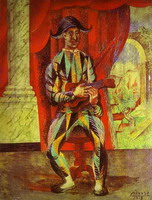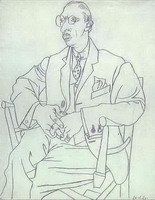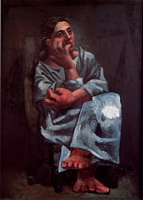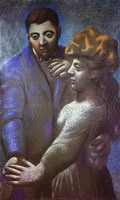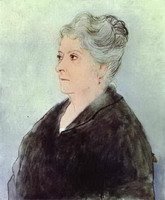 Cubism gradually became Picasso’s internally lived experience and liberated his brush. He later said: “When I think about it, I’d say I’m an artist without style”. “Style puts constraints on the artist, forcing a single viewpoint on things upon him, the same techniques, the same formula, year after year, his life long”. This, of course, was not the case of Picasso, the desperate daredevil of art.
The return to more readable and figurative painting was influenced by the logic of Picasso’s artistic development and the external factors: relations with Sergei Diaghilev’s ballet troupe, a trip to Rome, where everything was oversaturated with antiquity, interest in flesh and the human body, the monumental and material surroundings. "Olga Khokhlova", the Russian ballet dancer who soon became Picasso’s wife and the mother of his first son, wanted her own image to be more recognizable in Picasso’s portraits. Wish of the beloved would not have affected the artist, had it not been for his own mood. But in the late 1910s, all these factors came together and defined the new phase in Picasso’s work. While creating quite realistic paintings, he continued to experiment. In a way, the famous "Portrait Olga in an Armchair (1917)" was also experimental: Picasso took a keen interest in photography, its typical flattened shapes and the distortion of space, which was reflected in his works.
Cubism gradually became Picasso’s internally lived experience and liberated his brush. He later said: “When I think about it, I’d say I’m an artist without style”. “Style puts constraints on the artist, forcing a single viewpoint on things upon him, the same techniques, the same formula, year after year, his life long”. This, of course, was not the case of Picasso, the desperate daredevil of art.
The return to more readable and figurative painting was influenced by the logic of Picasso’s artistic development and the external factors: relations with Sergei Diaghilev’s ballet troupe, a trip to Rome, where everything was oversaturated with antiquity, interest in flesh and the human body, the monumental and material surroundings. "Olga Khokhlova", the Russian ballet dancer who soon became Picasso’s wife and the mother of his first son, wanted her own image to be more recognizable in Picasso’s portraits. Wish of the beloved would not have affected the artist, had it not been for his own mood. But in the late 1910s, all these factors came together and defined the new phase in Picasso’s work. While creating quite realistic paintings, he continued to experiment. In a way, the famous "Portrait Olga in an Armchair (1917)" was also experimental: Picasso took a keen interest in photography, its typical flattened shapes and the distortion of space, which was reflected in his works.
Classicism
 Cubism gradually became Picasso’s internally lived experience and liberated his brush. He later said: “When I think about it, I’d say I’m an artist without style”. “Style puts constraints on the artist, forcing a single viewpoint on things upon him, the same techniques, the same formula, year after year, his life long”. This, of course, was not the case of Picasso, the desperate daredevil of art.
The return to more readable and figurative painting was influenced by the logic of Picasso’s artistic development and the external factors: relations with Sergei Diaghilev’s ballet troupe, a trip to Rome, where everything was oversaturated with antiquity, interest in flesh and the human body, the monumental and material surroundings. "Olga Khokhlova", the Russian ballet dancer who soon became Picasso’s wife and the mother of his first son, wanted her own image to be more recognizable in Picasso’s portraits. Wish of the beloved would not have affected the artist, had it not been for his own mood. But in the late 1910s, all these factors came together and defined the new phase in Picasso’s work. While creating quite realistic paintings, he continued to experiment. In a way, the famous "Portrait Olga in an Armchair (1917)" was also experimental: Picasso took a keen interest in photography, its typical flattened shapes and the distortion of space, which was reflected in his works.
Cubism gradually became Picasso’s internally lived experience and liberated his brush. He later said: “When I think about it, I’d say I’m an artist without style”. “Style puts constraints on the artist, forcing a single viewpoint on things upon him, the same techniques, the same formula, year after year, his life long”. This, of course, was not the case of Picasso, the desperate daredevil of art.
The return to more readable and figurative painting was influenced by the logic of Picasso’s artistic development and the external factors: relations with Sergei Diaghilev’s ballet troupe, a trip to Rome, where everything was oversaturated with antiquity, interest in flesh and the human body, the monumental and material surroundings. "Olga Khokhlova", the Russian ballet dancer who soon became Picasso’s wife and the mother of his first son, wanted her own image to be more recognizable in Picasso’s portraits. Wish of the beloved would not have affected the artist, had it not been for his own mood. But in the late 1910s, all these factors came together and defined the new phase in Picasso’s work. While creating quite realistic paintings, he continued to experiment. In a way, the famous "Portrait Olga in an Armchair (1917)" was also experimental: Picasso took a keen interest in photography, its typical flattened shapes and the distortion of space, which was reflected in his works.




